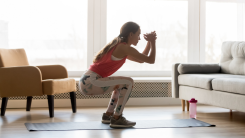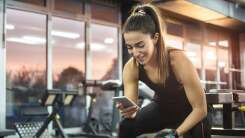The Best Quad Exercises for Leg Day

Ready for leg day? I’ve already shared my favorite exercises for hamstrings and for your glutes (a.k.a. your butt). It’s time to tackle the main muscle group we think of when we think of legs: the quads.
What are the quads?
Your quadriceps are a group of four muscles on the front of your thighs. They are the:
-
Rectus femoris (the one that runs vertically up the middle of your thigh)
-
Vastus lateralis (on the outside of your thigh)
-
Vastus medialis (on the inside of your thigh)
-
Vastus intermedius (underneath the rectus, in the middle of your thigh)
If you really want to geek out, there are some detailed images of each muscle here. All four muscles converge into one giant tendon at your knee, and that giant tendon is attached to your kneecap.
The function of these muscles is to straighten your knee. Three of the muscles (the ones with “vastus” in the name) start on your upper thighbone. When they contract, they pull on the kneecap, which pulls on the front of your shin, so your knee straightens.
The other muscle in this group, the rectus femoris, actually originates on the front of your pelvis. It straightens your knee and flexes your hip. (For example, if you’re doing a high-knees march, your hip flexors are what help you to raise your knees up high. The rectus is one of the hip flexors.)
There’s one more sub-muscle you may hear people talking about: the VMO, or vastus medialis oblique. This term refers to a portion of the vastus medialis that has oblique (diagonal) fibers.
So to work the quads, we’ll need to do exercises that ask us to straighten our knees. And since these are big muscles, we’ll have to load up a significant amount of weight to really challenge them. Ready to get started?
Best overall quad exercise: Squats
I know, you’re going to ask what else you can do, and I list some less-obvious exercises below. But squats really are one of the best leg exercises out there, and we need to take a minute to talk about why.
In a squat, you’re bending your knees and hips until you’re in a semi-seated position (coaches will sometimes tell you to sit in an invisible chair) and then standing up. The most common types of squats are:
-
Unweighted (“bodyweight”) squats, where the weight you’re moving is just your own body
-
Goblet squats, where you hold a dumbbell or kettlebell in your hands, at around chest level
-
Barbell squats, with the bar placed on your back. (There are “low bar” and “high bar” positions for the bar, but for our purposes today, you can put it wherever it’s most comfortable)
-
Front squats, where the bar rests on the front of your shoulders
Those are listed roughly in order of difficulty. Beginners often start with bodyweight squats and move on to goblet squats. Eventually the strength of your legs will outpace how much weight your hands can easily hold for a goblet squat, and that’s when you graduate to barbell squats. (It’s also possible to start on Day One with barbell squats, so don’t feel like you have to do goblets first.)
How to get the most out of squats if you can’t squat very low
Squats can be a tricky exercise to do well, but don’t write them off just because you have struggled with them in the past.
For many people, the biggest barrier to a good squat is flexibility in the ankles. To do a full squat—thighs parallel to the ground, or even lower—your ankles need to bend enough to let your knees move forward. The longer your thighbones are, the more ankle mobility you need. If your heels tend to rise off the ground as you squat, ankle mobility is probably your issue. Ankle mobility exercises can help. Squatting is itself an ankle mobility exercise, and squatting as low as you can will tend to improve your ability to squat over time. (Try pausing at the bottom of each squat as you are warming up.)
Elevating your heels can help too. The quick-and-dirty way to do this is to grab a pair of small weight plates, and stand with your heels on the plates. If your gym has a slant board (a wedge-shaped object you can stand on), try that instead. But you know what real weightlifters do? They wear shoes with a wedge built in. It’s not cheating, it’s just smart accessorizing. I wear squat shoes even though I have excellent ankle mobility. They help me to put my body in a stronger position.
Finally, there’s no law that you have to squat to (or below) parallel. Better to cut depth short than to give up squatting altogether. Half-squats still do a great job of building the quadriceps, and they’re arguably more specific to athletic purposes like running and jumping.
The only catch with squatting above parallel is that you need a way to keep your squats consistent. My favorite options to do this are:
-
Box squats. Place a plyo box or a bench behind you (angling the box so you’ll sit on the corner) and tap the box with your butt on each rep.
-
Anderson squats. Use a squat rack, and set the safeties to a height you can handle. Tap the bar gently on the safeties with each rep.
No barbell? Use the leg press
If you’re stuck at a Planet Fitness or some other gym where barbells aren’t available but you still want to work your legs with heavy weight, you can use the leg press. There are many types of leg press out there (horizontal, vertical, hack squat machines, etc) but they all do roughly the same thing: make you straighten your legs against resistance, in a squat-like motion.
Best single-leg squat exercises: Bulgarian split squats
Bulgarian split squats are great glute exercises, but they work the quads too. The more upright your torso is when doing the exercise, the more emphasis you’ll put on the quadriceps muscles of your front leg.
For Bulgarian split squats, rest one foot on a bench or other support behind you, and bend your front leg to raise and lower the weight. That weight might be a pair of dumbbells in your hands, a pair of dumbbells resting on your shoulders, or a barbell on your back, to name three of the most common ways to add resistance.
If you don’t like Bulgarian split squats, you can do regular split squats (with both feet on the ground), step-ups onto a box, or lunges in any direction you like. (Forward, reverse, and walking lunges being the most common choices.)
Best isolation squat exercises: Leg extension machine
All of the squat variations above (including the split squats) work your quads while also working your glutes and hamstrings. Sometimes you just want to give the quads some extra love all by themselves, and the leg extension machine is great for that.
There’s a myth that this machine is “bad for your knees,” because there is always a person saying that such-and-such exercise is always bad for your knees. I remember steering clear of this machine because I was taught that “physical therapists hate it.” But when I tore my ACL and needed to build quad muscle after surgery, what machine did my physical therapist have me on every week, as soon as I was cleared for it? You guessed it: the leg extension.
If your knees get cranky when you use this machine, the likely culprit is your positioning. The machine has a pivot or hinge where the arm can rotate. This should be right next to your knee, not way in front of or behind it. Fix that, and the machine will be a lot more comfortable.
window.videoEmbeds = window.videoEmbeds || []; window.videoEmbeds.push({
elemId: ‘video-container-fFrlExQSPt0 ‘,
data: {“slug”:”fFrlExQSPt0u00a0″,”start_time”:null,”url”:”https://www.youtube.com/watch?v=fFrlExQSPt0u00a0″},
videoPlayerType: ‘in-content’
});
Best kept secret: Somersault squats
Finally, what can you do if you don’t have a barbell or a set of leg machines? Goblet squats and kettlebell front squats are great options, but I’d like to share something special—it’s a bit tricky to set up, but a truly killer exercise when you get the hang of it. Behold, the somersault squat, a closed-chain quad exercise that is as close as you’ll get to a quad isolation outside the gym:
window.videoEmbeds = window.videoEmbeds || [];
window.videoEmbeds.push({
elemId: ‘video-container-OxwJja4rr4M’,
data: {“slug”:”OxwJja4rr4M”,”start_time”:”40″,”url”:”https://www.youtube.com/watch?v=OxwJja4rr4M&start=40″},
videoPlayerType: ‘in-content’
});
The idea is to dig your forearms into your hip creases, and hold a weight in your hands. You need to make sure your arms stay in that position, so that the weight isn’t sliding around and stays in contact with the top of your legs.
Then, straighten your knees without straightening your hips. I figure it’s called a “somersault” squat because your head goes down and your butt goes up in the air, as if you were going to do a somersault. Grab something heavy, and enjoy the burn.



